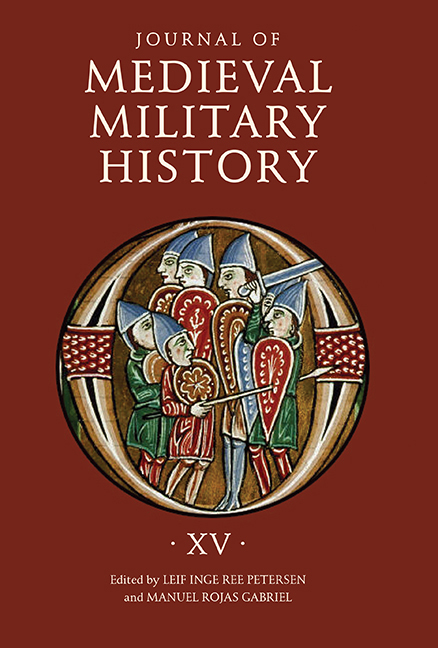Book contents
- Frontmatter
- Dedication
- Contents
- List of Illustrations
- Preface
- 1 Later Roman Grand Strategy: The Fortification of the urbes of Gaul
- 2 In Search of Equilibrium: Byzantium and the Northern Barbarians, 400–800
- 3 Evolving English Strategies during the Viking Wars
- 4 Norman Conquests: A Strategy for World Domination?
- 5 The Papacy and the Political Consolidation of the Catalan Counties, c. 1060–1100: A Case Study in Political Strategy
- 6 Alfonso VII of León-Castile in Face of the Reformulation of Power in al-Andalus, 1145–1157: An Essay in Strategic Logic
- 7 The Treaties between the Kings of León and the Almohads within the Leonese Expansion Strategy, 1157–1230
- 8 A Strategy of Total War? Henry of Livonia and the Conquest of Estonia, 1208–1227
- 9 The English Longbow, War, and Administration
- List of Contributors
- Journal of Medieval Military History
- De Re Militari and the Journal of Medieval Military History
2 - In Search of Equilibrium: Byzantium and the Northern Barbarians, 400–800
Published online by Cambridge University Press: 21 August 2019
- Frontmatter
- Dedication
- Contents
- List of Illustrations
- Preface
- 1 Later Roman Grand Strategy: The Fortification of the urbes of Gaul
- 2 In Search of Equilibrium: Byzantium and the Northern Barbarians, 400–800
- 3 Evolving English Strategies during the Viking Wars
- 4 Norman Conquests: A Strategy for World Domination?
- 5 The Papacy and the Political Consolidation of the Catalan Counties, c. 1060–1100: A Case Study in Political Strategy
- 6 Alfonso VII of León-Castile in Face of the Reformulation of Power in al-Andalus, 1145–1157: An Essay in Strategic Logic
- 7 The Treaties between the Kings of León and the Almohads within the Leonese Expansion Strategy, 1157–1230
- 8 A Strategy of Total War? Henry of Livonia and the Conquest of Estonia, 1208–1227
- 9 The English Longbow, War, and Administration
- List of Contributors
- Journal of Medieval Military History
- De Re Militari and the Journal of Medieval Military History
Summary
Understanding late Roman and early Byzantine long-term strategy towards the northern barbarians is a problematic endeavor. Recent historiography on late Roman frontier dynamics proposes a systematic Roman practice of building up a belt of client rulers, in the process profoundly changing societies brought within the Roman orbit. In return, these clients provided the Romans with extra sources of manpower and layers of security that stretched far beyond the frontiers. Unsurprisingly, the Classical frontier system of small client polities under Roman hegemony has attracted relatively little attention after it is assumed to have broken down in the north with the Gothic victory at Adrianople, the invasion of 406, and the subsequent establishment of federate groups within Roman territory. Arguably this was a problem the Romans brought upon themselves by integrating barbarians into their political structures and then involving them in Roman civil conflicts. The death knell for the Classical system of recognized client rulers in the north was the Hunnic hegemony that subverted what remained of the Roman client system.
In contrast to its Roman predecessor, early Byzantine client management strategy has until recently been treated as rather reactive and ad hoc, with relations with barbarians regarded as an aspect of inter-state diplomacy. Obolensky identified a Byzantine system of satellite or allied states north of the Caucasus, Black Sea, and lower Danube that were deliberately cultivated to secure the Empire's northern border, a system that persisted for centuries and gave rise to the Byzantine Commonwealth. However, his overall framework has not been further developed despite new archaeological and textual evidence, methodological advances, and a flourishing historiographical environment that have far advanced our knowledge. The focus of research has rather been Byzantine relations with particular geographical regions or barbarian groups, such as the Heruls, Gepids, Lombards, Avars, or Slavs, with fairly strict chronological delineations appropriate for each. Long-term developments are rarely followed much after the early seventh century, which becomes notoriously difficult due to the complex transition from the late Roman Empire to her medieval Byzantine successor, and to the extremely fragmentary nature of the sources, as is often pointed out with regard, for example, to Byzantine–Khazar relations.
- Type
- Chapter
- Information
- Journal of Medieval Military HistoryStrategies, pp. 36 - 67Publisher: Boydell & BrewerPrint publication year: 2017

